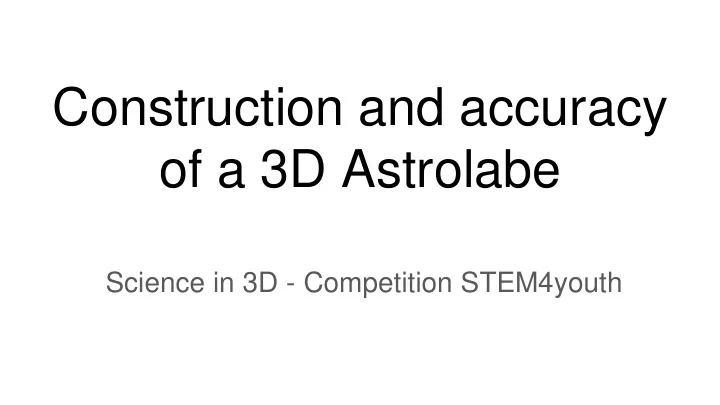

Construction and accuracy of a 3D Astrolabe Science in 3D - Competition STEM4youth
INTRODUCTION
Universe: inspirational source W e see a universe m arvellously arranged and obeying certain law s, but only dim ly understand these law s. Our lim ited m inds cannot grasp the m ysterious force that m oves the constellations. - Albert Einstein
The problem Is it possible to build a model of the universe? For instance…, an astrolabe using a 3D printer? Will it be precise? How much?
Hypothesis It is possible , although the plate and the calendar is made of cardboard, the rete will be a 3D piece! The accuracy is going to be good enough … which means that we don’t want to send a satellite to the outer space...
Stages 1st Stage Mercedes Jeremi Lucía 2nd Stage
Stages 3D Theory 1st Stage 2D Plans 1st model Astrolabe Mercedes Jeremi Lucía 2nd Stage
Stages 3D Theory 1st Stage 2D Plans 1st model Astrolabe Mercedes Jeremi Calendar other Lucía location 2nd Stage Study of the accuracy Report 2nd Model Improved
Conclusions Considering that an astrolabe is a medieval instrument …. It is a device with great accuracy Mean of 3 observations MAXIMUM ERROR < 22’ 30” 92% GUARANTEED
3 KEY IDEAS (that we learnt from each other)
1. Stereographic projection Greeks tried to find out a method to express a 3D object in 2D; the way that it is made mathematically is called projection. The stereographic projection shows that.
The mathematics involved in that geometric operation is quite simple. Considering properties, we can obtain importants results like the Fundamental equation of the Astrolabe (Theorem 1).
1.1. Circumferences and angles preservation. Distortions. Theorem 2 (preservation of Theorem 3 (preservation of angles) circumferences)
1.2. James Morrison plans of the astrolabe
1.2. Liechti rete
1.2. Plans of the STEM4Youth Astrolabe
2. 3D Designing and Printing 2D plans were moved to 3D models.
2. 3D Designing and Printing The 3D printing of the prototype of the astrolabe was done using the Prusa i3 printer. The final astrolabe has been printed mostly on a Creality printer, with an exception of a connector piece, that was printed using a Zortrax M200.
2.1 The Mater The Mater is the biggest part, and is the main plate of the astrolabe. Both printed graded plates are located directly on both sides of it. Unfortunately, in the printed version, it is only possible to have an indentation on one side, unless one is ready to cope with tremendous printing difficulties.
2.2 The Rete The rete is the part of the astrolabe that is used to point the location of the star on the graduated paper plate, with a representation of the sky. It is the most complicated piece, and many printing issues were met, mainly concerning its final precision.
2.3 The Rule The rule is used to check which grade on one set of grades corresponds to which on another grade. The holes can also be aligned with a star, to measure its angle relative to the ground. Its desing was relatively simple, however, the optimal way to secure the holes to the main part so that they hold sturdy had to be found.
2.4 The Alidade This part serves the exact same role as the Rule, but it does not have the part used to measure the hight of a star in the sky, as that can already be done with the Rule.
2.5 The Connector The Connector is a small, very carefully designed part, used to connect and hold together all other pieces of the astrolabe. It is used here instead of a screw and nut, due to the difficulty of printing small on a 3D printer, and because the rotating parts could loosen the nut. This is the only part of the final design that was printed on the Zortrax M200, because the plastic it uses is more flexible than PLA plastic used by the Creality printer. The connector piece, sticking out of the hole in the Mater
3. Normal distribution We generated 60 true observations using Stellarium.
3.1. Histogram and Normal Quantile Plot
3.2. Study of the accuracy The distribution for the mean (∑x)/n is N(μ,
2 QUESTIONS
1. Will it be the same for other latitudes? We study the precision of the astrolabe for Albacete, but it will be necessary to study other locations and compare them.
2. For a given error E and confidence C%, how many n observations do we need? Maybe, we should generalize Table 2 of the report.
1 IMAGE
Thanks everybody!
Recommend
More recommend